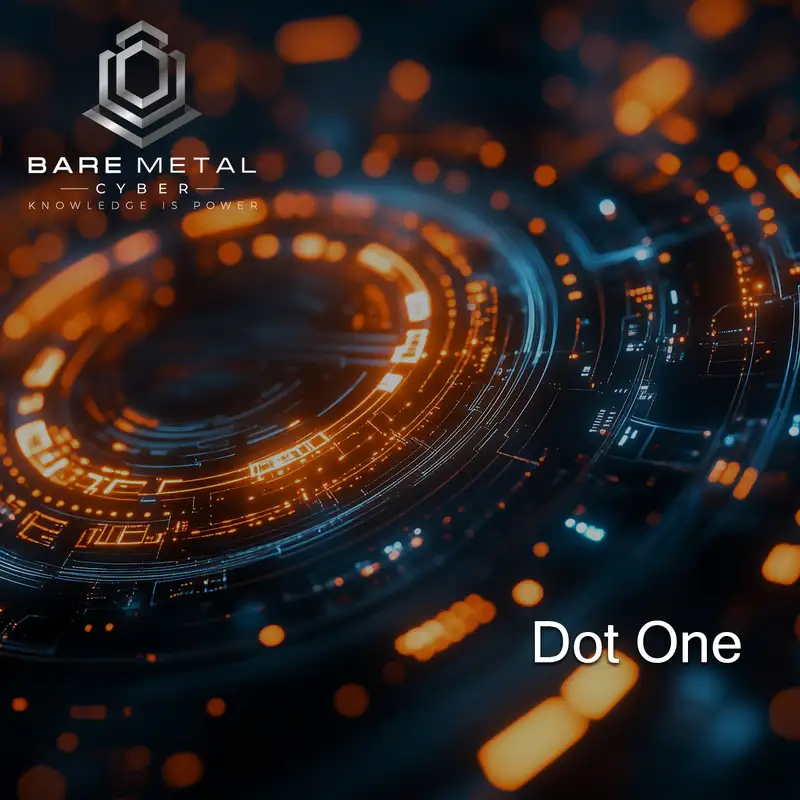What is Cybersecurity?
Welcome to this bonus episode of the BareMetalCyber podcast called a Dot One.
In this episode, we’re breaking down the essentials of cybersecurity—what it is, why it matters, and how it impacts individuals, businesses, and governments alike. We’ll explore the foundational concepts that protect our digital lives while encouraging you to think critically about your own cybersecurity habits and defenses.
Be sure to explore my library of books, including Hacked, my latest release. It explores fifteen of the most popular cyber movies, offering unique insights and uncovering lesser-known details about these films. But for now, let’s dive in!
What is Cybersecurity?
Cybersecurity, at its core, is the practice of safeguarding digital systems, networks, and the sensitive data they contain from unauthorized access, theft, or damage. In a world where nearly every aspect of daily life is connected to the digital realm—whether through smartphones, smart homes, or global networks—cybersecurity acts as the invisible shield protecting these systems. It ensures that the confidentiality, integrity, and availability of data remain intact, which is essential for everything from securing personal banking details to maintaining the functionality of critical infrastructure like power grids and healthcare systems. Cybersecurity isn’t a luxury or an optional add-on; it is a fundamental requirement for operating safely in the digital age.
The impact of cybersecurity—or the lack thereof—extends far beyond individuals. For businesses, a robust cybersecurity posture protects intellectual property, customer data, and financial assets, making it a cornerstone of operational resilience. Governments rely on cybersecurity to safeguard national security, protect election processes, and defend against threats from state-sponsored actors or activist groups. But it doesn’t stop there—individuals, too, face risks such as identity theft, phishing schemes, and ransomware attacks that can disrupt lives and drain resources. Understanding even the basics of cybersecurity empowers people, from individuals to global organizations, to recognize risks and take proactive measures to mitigate them.
This podcast episode will dive into the foundational concepts of cybersecurity, breaking them down into easily digestible pieces. Listeners will be guided to explore how cybersecurity impacts their lives and how their habits can either strengthen or weaken their digital defenses. The aim is to encourage critical thinking about everyday practices, like password creation and email usage, that can make a world of difference. By exploring the importance of cybersecurity through relatable examples and practical advice, this episode will offer listeners the knowledge they need to take their first steps toward a safer digital presence.
Common Cyber Threats
Cyber threats are as varied as the devices and networks they target, and understanding these dangers begins with recognizing the common types of cyberattacks. Phishing, one of the most pervasive threats, involves the use of deceptive emails or messages designed to trick individuals into revealing sensitive information like passwords or financial details. These messages often mimic trusted organizations, creating a false sense of urgency to compel victims to act quickly. Malware, on the other hand, represents an array of malicious software that can infiltrate systems, causing everything from data theft to complete operational shutdowns. Examples include viruses, ransomware, and spyware, each with unique methods of wreaking havoc on systems. These attacks are not random—they exploit human behavior and system vulnerabilities to gain unauthorized access or inflict damage.
Behind every cyberattack lies a motivation, which can help us understand why these threats continue to evolve and proliferate. Financial gain is one of the primary drivers, with attackers deploying ransomware to lock victims out of their systems until a payment is made or using banking trojans to steal sensitive financial information. Beyond monetary incentives, some attackers aim to disrupt or spy on their targets, often in the interest of nation-states or activist groups. Espionage campaigns can involve intricate strategies to extract classified information, while others seek to destabilize industries or societies by disrupting critical services. These motivations reflect a spectrum of goals, from personal greed to geopolitical strategy, making the threat landscape more complex and unpredictable.
As technology advances, so do the tactics used by cybercriminals, resulting in an ever-evolving threat landscape. The rise of artificial intelligence has introduced new tools for attackers, enabling them to automate and refine their methods with frightening precision. AI can be used to craft highly convincing phishing emails, bypass traditional security measures, or even mimic human behavior during an attack. At the same time, the expansion of cloud computing and the Internet of Things (IoT) has created a wealth of new vulnerabilities. Cloud environments can serve as attractive targets due to the large volumes of sensitive data they store, while IoT devices often lack robust security measures, making them entry points for attackers. These trends highlight the critical need for constant vigilance and adaptation in cybersecurity, as the tools and strategies of today may not suffice to counter the threats of tomorrow.
Fundamentals of Cyber Defense
Defending against cyber threats starts with the basics, and one of the most fundamental steps is creating strong, unique passwords for each account. A good password combines upper and lowercase letters, numbers, and symbols, making it difficult for attackers to guess. It should also avoid predictable patterns like birthdays or common words. However, even a well-crafted password isn’t foolproof. Multi-factor authentication (MFA) adds another critical layer of security, requiring a second form of verification, such as a code sent to your phone or biometric input like a fingerprint. This combination significantly reduces the chances of unauthorized access, even if passwords are compromised. Think of it as having a second lock on a door—if one fails, the other is there to protect you.
Recognizing threats is another vital skill in cyber defense, especially given the sophistication of modern attacks. Phishing remains a pervasive problem, where attackers craft emails or messages designed to trick users into clicking malicious links or revealing sensitive information. These attempts often mimic legitimate communication from banks, employers, or even friends, making them particularly dangerous. Training to identify these red flags—like mismatched email addresses, generic greetings, or urgent requests—can save individuals and organizations from falling victim. Beyond phishing, social engineering tactics exploit human trust to gain access to secure systems, often by impersonating authority figures or creating fabricated scenarios. Awareness of these techniques helps people spot attempts before they succeed, turning potential victims into proactive defenders.
Regularly updating systems and software is another cornerstone of effective cyber defense. Hackers frequently exploit vulnerabilities in outdated software, which is why patching and updates are so critical. These updates not only fix bugs but also address security flaws that could otherwise leave systems open to attack. Downloading software or updates should always come from trusted sources, as attackers often hide malicious code in counterfeit files. Ensuring that devices, from smartphones to laptops, run the latest security patches reduces the risk of being targeted by known exploits. While updates can be inconvenient, they are essential tools in maintaining a strong defensive posture in an increasingly complex digital world.
Careers and Opportunities in Cybersecurity
The field of cybersecurity is experiencing an unprecedented demand for professionals, making it one of the most dynamic and rewarding career paths available today. Across industries ranging from healthcare to finance and government, organizations are grappling with a critical skills shortage. Roles such as cybersecurity analysts, engineers, and Chief Information Security Officers (CISOs) are in high demand, with responsibilities that span from monitoring threats to designing robust security frameworks. This shortage means that opportunities abound for individuals with the right skills and knowledge, offering not only job security but also the chance to make a tangible impact in protecting critical systems and data. For those drawn to the challenge of staying ahead of cybercriminals, the career potential is virtually limitless.
Entering the cybersecurity field requires a combination of foundational knowledge, practical skills, and credentials that demonstrate expertise. Certifications like Security+, CISSP, and CEH are often the first steps for aspiring professionals, providing an industry-recognized benchmark of skills. These certifications cover essential areas such as risk management, penetration testing, and system security, equipping individuals with the knowledge they need to tackle real-world challenges. However, theory alone isn’t enough—hands-on experience is critical. Engaging in labs, internships, or even participating in capture-the-flag competitions helps bridge the gap between learning and doing. This practical exposure not only builds technical proficiency but also instills the problem-solving mindset that is essential in cybersecurity.
Success in cybersecurity also depends on a commitment to continuous learning, as the landscape of threats and technologies evolves rapidly. Staying informed about emerging trends, such as AI-driven attacks or advancements in quantum computing, ensures that professionals remain relevant and effective. Networking within the cybersecurity community is equally valuable, offering opportunities to exchange knowledge, find mentors, and collaborate on solutions to shared challenges. Conferences, online forums, and local meetups provide platforms for engagement, helping professionals stay connected and inspired. This combination of staying current and building relationships creates a strong foundation for growth in a career that is as rewarding as it is essential.
Thanks for tuning in to this Bonus episode of BareMetalCyber! If you enjoyed the podcast, please subscribe and share it. Follow me on LinkedIn at Jason-edwards.me for more cybersecurity insights, and join the tens of thousands subscribed to my newsletters at baremetalcyber.com for exclusive content on cybersecurity, leadership, and education. Don’t forget to visit cyberauthor.me to explore my books and resources. Your support keeps this community growing—stay safe, stay informed, and remember: knowledge is power.

